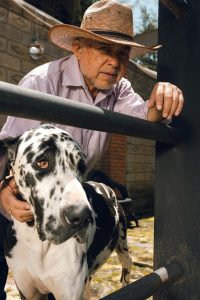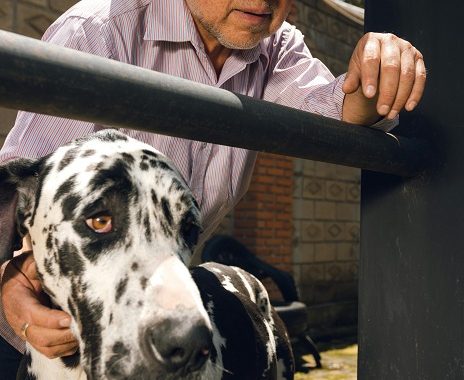
Training senior dogs can be a rewarding experience that fosters a strong bond between you and your furry companion. While it’s true that older dogs may have well-established habits, their capacity to learn and adapt remains intact.
In this article, we’ll explore effective training techniques tailored specifically for senior dogs, ensuring a happy and harmonious relationship between you and your aging canine friend.
-
Patience is Key:
Training senior dogs demands an extra dose of patience. Similar to humans, these seasoned canines may require more time to comprehend and execute new commands.
It’s crucial to approach training sessions with empathy, acknowledging their potential slower pace. Give your senior dog the time to absorb information and respond at their own rhythm.
Utilize positive reinforcement generously; treats and praise become powerful tools, encouraging and reinforcing desired behaviors.
By cultivating a patient and supportive atmosphere, you establish a foundation for successful training sessions that cater to the unique learning pace of senior dogs, fostering a positive and enriching experience.
-
Adapt to Physical Limitations:
Understanding and adapting to your senior dog’s physical limitations is crucial for effective training. Acknowledge any arthritis or joint issues they may have, tailoring exercises to alleviate discomfort. Opt for low-impact activities, incorporating gentle exercises that promote flexibility without straining their joints.
Keep training sessions short and focused to prevent fatigue and ensure your senior dog remains engaged and comfortable. By addressing their unique physical needs, you create a training environment that supports their well-being and encourages a positive learning experience for your aging canine companion.
-
Use Clear and Simple Commands:
In training senior dogs, the key to success lies in clear and straightforward communication. Opt for uncomplicated and consistent commands, ensuring they are easily understood by your aging canine companion.
Supplement verbal cues with gestures or visual prompts to reinforce understanding. This dual approach enhances your senior dog’s comprehension, facilitating effective instruction and minimizing confusion.
By keeping commands simple and reinforcing them visually, you create an environment where your senior dog feels confident and capable, promoting a more successful and enjoyable training experience for both of you.
Best Training Techniques for Senior Dogs
-
Engage in Mental Stimulation:
For senior dogs, mental stimulation is a vital component of their overall well-being. In addition to physical exercise, introducing puzzle toys, interactive games, and novel experiences into their daily routine is essential.
These activities serve to keep their cognitive faculties sharp, preventing boredom and fostering a healthier and happier senior pup. The engagement of their minds through stimulating activities not only adds joy to their lives but also contributes to maintaining mental acuity, supporting cognitive function as they age.
Make mental stimulation a consistent part of your senior dog’s routine for a more enriched and fulfilling life in their golden years.
Extra Large Pet Training and Puppy Pads Pee Pads for Dogs
-
Build on Previous Training:
Building on previous training is a cornerstone for effectively training senior dogs. These seasoned companions often bring a wealth of prior training and life experiences to the table.
By acknowledging and utilizing this existing knowledge, trainers can expedite the learning process. Reinforcing positive behavior becomes a crucial aspect, serving to enhance the foundation laid in their earlier years.
Gently correcting any undesirable habits ensures that the senior dog unlearns negative behaviors while maintaining a positive training environment.
Recognizing the unique strengths and challenges of each individual dog is key, allowing trainers to tailor their approach and capitalize on the wealth of skills and understanding that senior dogs bring to the training sessions.
This approach not only facilitates a smoother training process but also strengthens the bond between the senior dog and their owner.
Dog Balance Disc Cushion 14″ – With 2 Exercises and Pump
-
Regular Health Checkups:
Regular health checkups for senior dogs play a pivotal role in optimizing their training experience. Before introducing a new training routine, it’s essential to confirm your senior dog’s overall well-being through routine veterinary visits.
These checkups serve as proactive measures to detect and address any underlying health issues that might impede their ability to learn or engage in specific activities. Senior dogs, often susceptible to age-related conditions like arthritis or diminished sensory functions, benefit immensely from timely health assessments.
By promptly addressing health concerns, you not only ensure the effectiveness of the training but also contribute to your dog’s overall quality of life.
These checkups provide valuable insights into your dog’s physical condition, allowing you to tailor the training regimen to suit their capabilities and provide any necessary accommodations.
A proactive approach to health ensures that your senior dog can enjoy a fulfilling and comfortable training journey, promoting both mental and physical well-being.
-
Adaptability and Flexibility:
Adaptability and flexibility are paramount when training senior dogs, considering the diverse personalities and experiences each dog brings.
Understanding that there is no one-size-fits-all approach, tailor your training techniques to cater to your senior dog’s specific needs and preferences.
Observing their reactions and receptiveness to different methods is crucial. Should a particular training method prove ineffective, be open to adjusting your strategy. Some senior dogs may respond better to visual cues, while others may require more hands-on guidance.
Patience is key as you navigate through the trial-and-error process of discovering what resonates best with your unique canine companion.
By embracing adaptability and flexibility, you create an environment conducive to successful training, fostering a stronger connection and mutual understanding between you and your senior dog.
Positive Training for Aggressive and Reactive Dogs Book
-
Celebrate Small Wins:
In the realm of training senior dogs, celebrating small wins is a cornerstone of success. This involves not only recognizing but also actively rewarding your canine companion for incremental achievements during training sessions.
Positive reinforcement, such as offering favorite treats or showering them with praise, creates a positive association with the desired behavior.
Whether it’s mastering a new command or displaying a commendable response, timely acknowledgment and rewards serve as powerful motivators for senior dogs.
This reinforcement not only reinforces their training but also instills a sense of accomplishment, boosting their confidence and enthusiasm.
By consistently celebrating these small victories, you foster a supportive and encouraging training environment that deepens the bond between you and your senior dog, making the learning process enjoyable and fulfilling for both parties.
Best Reusable Dog Training Pads
Conclusion:
Training senior dogs requires a thoughtful and patient approach that considers their physical and mental well-being.
By understanding and adapting to your senior dog’s unique characteristics, you can create a positive and enriching training experience that strengthens your bond and enhances their overall quality of life.
Remember, it’s never too late to teach an old dog new tricks with the right blend of patience, consistency, and love.
Further Reading:
7 Effective Dog Training Methods – For Old Dogs and New Dogs
How to Teach an Old Dog New Tricks
FAQs:
What is the best way to train an older dog?
The best way to train an older dog is through patient, positive reinforcement. Acknowledge and reward small successes, adapting commands to be clear and consistent. Tailor exercises to accommodate any physical limitations and engage in both mental and physical stimulation. Regular veterinary checkups ensure health doesn’t hinder training progress. Building on existing training and being adaptable to the dog’s unique needs promotes effective learning. Celebrate small wins to boost confidence and create a supportive training environment, fostering a strong bond with your older canine companion.
�
Can older dogs still be trained?
Absolutely! Older dogs can be trained effectively. While they may take a bit longer to learn new tricks due to established habits, their capacity to learn and adapt remains intact. Patience, positive reinforcement, and adapting training methods to accommodate any physical limitations are key. Mental stimulation and building on prior training also contribute to successful outcomes. Regular health checkups ensure they’re in good condition for training, and celebrating small wins boosts their confidence. With the right approach, training older dogs can be a rewarding experience that enhances the bond between you and your canine companion.
�
How do you train an older dog with bad habits?
- Identify Specific Behaviors: Pinpoint the undesirable habits your older dog exhibits.
- Be Consistent: Establish clear and consistent rules to avoid confusion.
- Positive Reinforcement: Use positive reinforcement techniques, rewarding good behavior.
- Redirect Attention: Distract from bad habits by redirecting focus to positive activities.
- Patience and Understanding: Older dogs may take time to adapt; be patient and understanding.
- Seek Professional Help: Consult a professional dog trainer for guidance and support.
- Health Check: Ensure there are no underlying health issues influencing behavior; consult a veterinarian if needed.
��
Is it possible to train a 2 year old dog?
Absolutely! Training a 2-year-old dog is entirely possible. While puppies are often the focus of early training, older dogs, including those at the age of 2, are still capable of learning and adapting to new commands. Patience, positive reinforcement, and consistency are key. Start with basic commands and gradually progress to more advanced ones. Tailor the training to suit your dog’s personality and energy level. With dedication and a positive approach, you can successfully train a 2-year-old dog and strengthen your bond with them.
